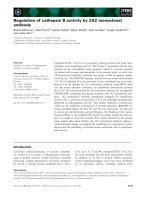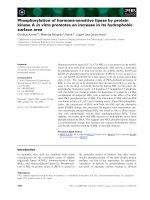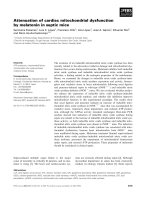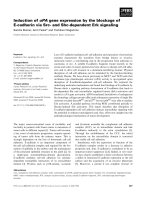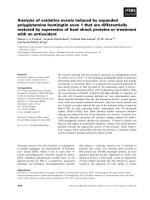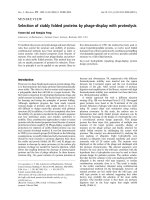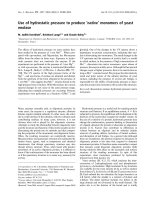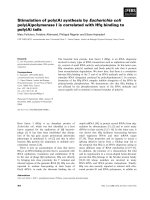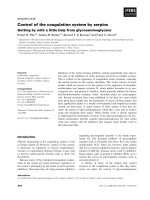báo cáo khoa học: "Use of silver nanoparticles increased inhibition of cell-associated HIV-1 infection by neutralizing antibodies developed against HIV-1 envelope proteins" potx
Bạn đang xem bản rút gọn của tài liệu. Xem và tải ngay bản đầy đủ của tài liệu tại đây (2.57 MB, 9 trang )
RESEARC H Open Access
Use of silver nanoparticles increased inhibition of
cell-associated HIV-1 infection by neutralizing
antibodies developed against HIV-1 envelope
proteins
Humberto H Lara
1
, Liliana Ixtepan-Turrent
2
, Elsa N Garza Treviño
2
and Dinesh K Singh
1*
Abstract
Background: HIV/AIDS pandemic is a worldwide public health issue. There is a need for new approaches to
develop new antiviral compounds or other therapeutic strategies to limit viral transmission. The envelope
glycoproteins gp120 and gp41 of HIV are the main targets for both silver nanoparticles (AgNPs) and neutralizing
antibodies. There is an urgency to optimize the efficiency of the neutralizing antibodies (NABs). In this study, we
demonstrated that there is an additive effect between the four NABs and AgNPs when combined against cell-
associated HIV-1 infection in vitro
Results: Four NABs (Monoclonal antibody to HIV-1 gp41 126-7, HIV-1 gp120 Antiserum PB1 Sub 2, HIV-1 gp120
Antiserum PB1, HIV-1 gp120 Monoclonal Antibody F425 B4e8) with or without AgNPs of 30-50 nm in size were tested
against cell free and cell-associated HIV
IIIB
virus. All NABs inhibited HIV-1 cell free infection at a dose response manner,
but with AgNPs an antiviral additive effect was not achieved Although there was no inhibition of infection with cell-
associated virus by the NABs itself, AgNPs alone were able to inhibit cell associated virus infection and more
importantly, when mixed together with NABs they inhibited the HIV-1 cell associated infection in an additive manner.
Discussion: The most attractive strategies to deal with the HIV problem are the development of a prophylactic
vaccine and the development of effective topical vaginal microbicide. For two deca des a potent vaccine that
inhibits transmission of infection of HIV has been searched. There are vaccines that elicit NABs but none of them
has the efficacy to stop transmission of HIV-1 infection. We propose that with the addition of AgNPs, NABs will
have an additive effect and become more potent to inhibit cell-associated HIV-1 transmission/infection.
Conclusions: The addition of AgNPs to NABs has significantly increased the neutralizing potency of NABs in
prevention of cell-associated HIV-1 transmission/infection. Further exploration is required to standardize
potentiation of NABs by AgNPs. It is also required to evaluate in vivo toxicity of AgNPs before AgNPs could be
incorporated in any antiviral vaginal creams.
Keywords: Silver Nanoparticles, Neutralizing Antibodies, HIV, gp12 0, gp41
Introduction
The pandemic of Acquired Immunodeficiency Syndrome
(AIDS), caused by the Human Immunodeficiency Virus
Type 1 (HIV-1) infection, is a worldwide public health
issue [1]. The latest estimates by the Jo int United
Nations Program on HIV/AIDS (UNAIDS) indicate that
more than 33.3 million people worldwide are living with
HIV-1 infection or AIDS.
The medical use of the cocktail drugs known as highly
active antiretroviral therapies (HAART) has significantly
reduced morbidity and mortality am ong AIDS patients
[2,3]. Unfortunately, the achievement of HAART is
insufficient and compromised by the evolution of drug
resistance HIV strains [4]. Consequently, the search for
* Correspondence:
1
Department of Life Sciences, Winston-Salem State University, Winston
Salem, NC, 27110, USA
Full list of author information is available at the end of the article
Lara et al. Journal of Nanobiotechnology 2011, 9:38
/>© 2011 Lara et al; licensee BioMed Central Ltd. This i s a n Op en Ac cess a rticle dist ributed un der t he term s of the Creative Commons
Attribution License (http://creativecommons .org/licenses/by/2.0), which permits unrestricted use, distribution, and reproduction in
any medium, provided the original work is prope rly cited.
new therapies to inhibit viral infection or to restore the
damaged immune system in HIV/AIDS patients con-
tinues . Newly discovered drugs are consta ntly evaluated
as therapeutic drug candida tes. These new drugs are
eagerly awaited for the growing number of HIV-infected
individuals who have developed resistance to the cur-
rently existing antiretrovirals [5].
The most attractive strategies to deal with the HIV
problem are the development of a prophylactic vaccine
and the development of an effective topical vaginal and
rectal microbicides. Both approaches are essential and
eventually a combination of the two may prove to be
most effective strategy in controlling the HIV-1 epi-
demic by diminishing the in cidence of human-to-human
transmission events [6].
The discovery of an HIV-1 vaccine that elicits broadly
efficient n eutralizing antibodies still remains an elusive
goal especially after the recent failure of the leading T
cell based HIV vaccine in human efficacy trials [7]. The
envelope glycoproteins gp120 and gp41 that are the
main targets for neutralizing antibodies are partially
shielded by N-linkedglycans and other structurally-
imposed steric constraints that limit antibody access to
potential neutralization epitope s. The complex level of
antigenic diversity of HIV-1, the shielding of key epi-
topes within the three dimensional structure of the
native Env trimer, and the failure of newer versions of
Env proteins to elicit broadly reactive antibodies have
led to some pessimism regarding the potential to ever
elicit high titers of neutralizing antibodies against
diversestrainsofHIV-1.Thereforethereisaneedto
maximize the efficiency of whatever titers of neutralizing
antibodies generated by vaccines [8].
A significant correlation is usually reported linking the
ability of an antibody to neutralize HIV-1 in vitro and
to protect in vivo against HIV-1 in animal models.
Some vaccine research studies have measured the cap-
ability of specific NABs t o protect against SHIV infe c-
tion, and found that efficient immunity is achieved only
when the serum concentration of NABs in the chal-
lenged animals is many mult iple s of the in vitro neutra-
lization titer. Normally these NABs require relatively
high antibody concentrations that may be highly difficult
to reach by vaccination [9].
Silver ions in complexes or c ompounds have been
used for centuries to disinfect fluids, solids and tissues
[10]. There is no cross resistance with antibiotics [11]
and probably there is also no induction of antimicrobial
resistance by silver ions [12]. The Crede’s solution (sil-
ver nitrate 0.2%) has been used to prevent the Neonatal
conjunctivitis ("ophtalmia neonatorum ”) which is a form
of bacterial conjunctivitis contracted during delivery.
The eyes are infected during passage through the birth
canal from a mother infected with either Neisseria
gonorrhoeae or Chlamydia trachomatis. Crede’s solution
was used to prevent the condition. If left untreated it
could cause blindness [13]. Also Silver sulfadiazine is
widely used by physicians to treat severe burns in skin,
this topical cream not only acts a gainst infections, but
also against inflammation and enhance the healing of
the tissue. The many attempts to find a better remedy
for the topical treatment of b urns than silver sulphadia-
zine have so far been without success [14].
Recent advances in nanotechnology have enabled the
scientific community to investigate and manipulate
materials at nanometer level. Nano-based delivery sys-
tems can be adapted to modulat e drug release, reduce
drug-associated toxicity, protect drugs from metabolism,
and t arget drugs to affected cells, tissues, and compart-
ments [15-19]. Nowadays we can use pure silver of nan-
ometer sizes. We previously reported that AgNPs inhibit
HIV-1 a nd that these nanoparticles attach to the gp120
[20]. Then we investigated the mode of antiviral act ion,
with a panel of tests we probed that AgNPs:- a) attach
to the envelope of the HIV-1 inhibiting the interaction
with CD4 receptor,:-b) inhibits a wide range of HIV-1
regardless of the tropism,:-c) inhibit entry an d fus ion of
the virus to the target cell at a non-toxic range. AgNPs
proved to be more efficient than silver ions at non-cyto-
toxic levels [21].
With the above antiviral characteristics, AgNPs are
appealing to be included as an active compound in a
vaginal topical gel. We previously demonstrated that
Polyvinylpyrrolidone (PVP) AgNPs mixed in a topical
gel, inhibit the transmission of infection when applied to
the human cervical tissue in a model for explants, at a
non-toxic range, and more significantly, AgNPs acts
rapidly in less than a minute and p rotect the human
cervical tissue for more than 48 hours even after an
extensive wash of the gel, without any toxicity to the
human cervical explants [22].
Inthepresentstudywedecidedtoinvestigatethe
additive effect of AgNPs with four NABs (Monoclonal
antibody to HIV-1 gp41 126-7 [23], HIV-1 gp120 Anti-
serum PB1 Sub 2, HIV-1 gp120 Antiser um PB1 [24-26],
HIV-1 gp120 Monoclonal Antib ody F425 B4e8 [27]) as
both act against viral envelope glycoprotein trimers on
the surface of the virus that mediate receptor binding
and entry.
Results
Inhibition of cell free HIV
IIIB
virus infection by Monoclonal
antibody to HIV-1 gp41 (126-7) and Silver Nanoparticles
in U373-MAGI-CXCR4
CEM
cells
In this experiment, w e evaluated inhibition of cell free
HIV-1
IIIB
virus infection by monoclonal antibody to
HIV-1 gp41 (126-7) in U373-MAGI-CXCR4
CEM
cells.
The toxic dose of 1 mg/ml AgNPs was ascertained on a
Lara et al. Journal of Nanobiotechnology 2011, 9:38
/>Page 2 of 9
cytotoxicity assay and was found to be 28% (data not
shown). The AgNPs alone showed 40% inhibition of cell
free HIV-1
IIIB
virusinfectionatthisconcentration
against a control (virus infection wihout AgNPs). The
monoclonal antibody to HIV-1 gp41 (126-7) alone
showed ability to inhibit infection (16-25%) of HIV-1
IIIB
inadoseresponsemanner.Thedifferentdilutionsof
NAB, when added with AgNPs at 1 mg/mL, increased
HIV-1
IIIB
inhibition by 47-63% (P < 0.002) until the
NAB dilution of 1:160. There was no additive effect
observed.(Figure 1).
Inhibition of cell free HIV
IIIB
virus infection by HIV-1
gp120 Antiserum (PB1) and Silver Nanoparticles in U373-
MAGI-CXCR4
CEM
cells
The HIV-1 gp120 Antiserum (PB1) alone showed inhibi-
tion of HI V-1
IIIB
infection in a dose response manner
(10-30%). The addition of AgNPs at 1 mg/mL showed
no effect in this experiment. The HIV-1 gp120 Anti-
serum (PB1) dilutions 1:20 and 1:40 showed mild inhibi-
tion alone when compared to the inhibition by the
mixture o f AgNPs and NABs (47 and 41% inhibition, P
< 0.065). After that dilution inhibition of HIV-1
IIIB
virus decreased and was less than AgNPs alone 40%,
(Figure 2).
Inhibition of cell free HIV
IIIB
virus infection by HIV-1
gp120 Antiserum (PB1 Sub 2) and Silver Nanoparticles in
U373-MAGI-CXCR4
CEM
cells
The HIV-1 gp120 Antiserum (PB1 sub 2) alone was
found to have the best ability to inhibit infection of
HIV-1
IIIB
(18-71%) in a dose response manner com-
pared to other three NABs. When added with AgNPs at
1 mg/mL, an increase of inhibitory effect was observed
unti l the NAB dilution of 1:640. The ad dition of AgNP s
Figure 1 HIV inhibi tion of cell free HIV
IIIB
virus infection by
Monoclonal antibody to HIV-1 gp41 (126-7) and Silver
Nanoparticles. Serial two-fold dilutions of Monoclonal antibody to
HIV-1 gp41 (126-7) were added to 10
5
TCID
50
of HIV-1
IIIB
cell-free
virus. After incubation for 5 minutes, they were added with or
without silver nanoparticles at 1 mg/mL. Then the mixture was
placed into 96-well plates with indicator cells (U373-MAGI-
CXCR4
CEM
) at a final 0.2-0.5 m.o.i. Assessment of HIV-1 infection was
made with a luciferase-based assay. The percentage of residual
infectivity after treatment was calculated with respect to the
positive control of untreated virus. The assay was performed in
triplicate; the data points represent the mean, and the solid lines
are nonlinear regression curves done with SigmaPlot 10.0 software.
By means of Mann- Whitney Rank Sum test we compared the
difference in the median values between the two groups (only
AgNPs and AgNPs with antibody to HIV-1 gp41 126-7) is greater
than would be expected by chance; there is a statistically significant
difference (P < 0.002).
Figure 2 HIV inhibi tion of cell free HIV
IIIB
virus infection by
HIV-1 gp120 Antiserum (PB1) and Silver Nanoparticles. Serial
two-fold dilutions of HIV-1 gp120 Antiserum (PB1) was added to 10
5
TCID
50
of HIV-1
IIIB
cell-free virus. After incubation for 5 minutes, they
were added with or without silver nanoparticles at 1 mg/mL. Then
the mixture was placed into 96-well plates with indicator cells
(U373-MAGI-CXCR4
CEM
) at a final 0.2-0.5 m.o.i. Assessment of HIV-1
infection was made with a luciferase-based assay. The percentage of
residual infectivity after treatment was calculated with respect to
the positive control of untreated virus. The assay was performed in
triplicate; the data points represent the mean, and the solid lines
are nonlinear regression curves done with SigmaPlot 10.0 software.
By means of Mann- Whitney Rank Sum test we compared the
difference in the median values between the two groups (only
AgNPs and AgNPs with antibody to HIV-1 gp120 Antiserum PB1) is
not great enough to exclude the possibility that the difference is
due to random sampling variability; there is not a statistically
significant difference (P < 0.065).
Lara et al. Journal of Nanobiotechnology 2011, 9:38
/>Page 3 of 9
increased HIV-1
IIIB
inhibition (42-72%, P < 0.008). there
was no additive effect. (Figure 3).
Inhibition of cell free HIV
IIIB
virus infection by HIV-1
gp120 Monoclonal Antibody (F425 B4e8) and Silver
Nanoparticles in U373-MAGI-CXCR4
CEM
cells
The HIV-1 gp120 Monoclonal Antibody (F425 B4e8)
was found to mildly inhibit infection of HIV-1
IIIB
in a
dose response manner (5-11%). When added with
AgNPs at 1 mg/mL no effect was observed. The use of
AgNPs along with HIV-1 gp120 Monoclonal Antibody
(F425 B4e8) showed inhibition efficacy of NAB 36-40%
(P < 0.008) which was less than AgNPs alone (Figure 4).
Inhibition of cell associated HIV
IIIB/H9
virus infection by
Monoclonal antibody to HIV-1 gp41 (126-7), and Silver
Nanoparticles in U373-MAGI-CXCR4
CEM
cells
The monoclonal antibody to HIV-1 gp41 (126-7) itself
has very little effect (6-10% inhibition) on cell associated
HIV-1
IIIB/H9
virus infection. The AgNPs however
showed inhibition of HIV-1
IIIB/H9
virus infection (50%)
at 1 mg/mL concentration. The monoclonal antibody to
HIV-1 gp41 (126-7) when added with AgNPs showed
additive effect till 1:640 dilutions, increasing inhibition
of HIV-1
IIIB/H9
viru s to 62-71% (P < 0.002). This inhibi-
tory effect was however lost after 1:640 dilution of NAB
and only the inhibition of AgNPs alone were observed
(Figure 5).
Inhibition of cell associated HIV
IIIB/H9
virus infection by
HIV-1 gp120 Antiserum (PB1) and Silver Nanoparticles in
U373-MAGI-CXCR4
CEM
cells
The HIV-1 gp120 Antiserum (PB1) showed 3-12% inhibi-
tory effect on cell associated HIV-1
IIIB/H9
virus, addition of
AgNPs at 1 mg/mL increased inhibition of virus (60-68%
inhibition, P < 0.002) suggesting a strong additive effect of
AgNPs on HIV-1 gp120 Antiserum-PB1(Figure 6).
Figure 3 HIV inhibi tion of cell free HIV
IIIB
virus infection by
HIV-1 gp120 Antiserum (PB1 Sub 2) and Silver Nanoparticles.
Serial two-fold dilutions of HIV-1 gp120 Antiserum (PB1 Sub 2) was
added to 10
5
TCID
50
of HIV-1
IIIB
cell-free virus. After incubation for 5
minutes, were added with or without silver nanoparticles at 1 mg/
mL. Then the mixture was placed into 96-well plates with indicator
cells (U373-MAGI-CXCR4
CEM
) at a final 0.2-0.5 m.o.i. Assessment of
HIV-1 infection was made with a luciferase-based assay. The
percentage of residual infectivity after treatment was calculated with
respect to the positive control of untreated virus. The assay was
performed in triplicate; the data points represent the mean, and the
solid lines are nonlinear regression curves done with SigmaPlot 10.0
software. By means of Mann- Whitney Rank Sum test we compared
the difference in the median values between the two groups (only
AgNPs and AgNPs with antibody to HIV-1 gp120 Antiserum PB1
Sub 2) is greater than would be expected by chance; there is a
statistically significant difference (P < 0.008).
Figure 4 HIV inhibi tion of cell free HIV
IIIB
virus infection by
HIV-1 gp120 Monoclonal Antibody (F425 B4e8) and Silver
Nanoparticles. Serial two-fold dilutions of HIV-1 gp120 Monoclonal
Antibody (F425 B4e8) was added to 10
5
TCID
50
of HIV-1
IIIB
cell-free
virus. After incubation for 5 minutes, they were added with or
without silver nanoparticles at 1 mg/mL. Then the mixture was
placed into 96-well plates with indicator cells (U373-MAGI-
CXCR4
CEM
) at a final0.2-0.5 m.o.i. Assessment of HIV-1 infection was
made with a luciferase-based assay. The percentage of residual
infectivity after treatment was calculated with respect to the
positive control of untreated virus. The assay was performed in
triplicate; the data points represent the mean, and the solid lines
are nonlinear regression curves done with SigmaPlot 10.0 software.
By means of Mann- Whitney Rank Sum test we compared the
difference in the median values between the two groups (only
AgNPs and AgNPs with antibody to HIV-1 gp120 Monoclonal
Antibody F425 B4e8) is greater than would be expected by chance;
there is a statistically significant difference (P < 0.008).
Lara et al. Journal of Nanobiotechnology 2011, 9:38
/>Page 4 of 9
Inhibition of cell associated HIV
IIIB/H9
virus infection by
HIV-1 gp120 Antiserum (PB1 Sub 2) and Silver
Nanoparticles in U373-MAGI-CXCR4
CEM
cells
The HIV-1 gp120 Antiserum (PB1 sub 2 ) alone showed
3-12% inhibition of cell associated HIV-1
IIIB/H9
virus
infection in a dose response manner. This inhibition
was increased to 61-69% inhibition (P < 0.002) when
added with AgNPs at 1 mg/ mL concentration indicating
an additive effect between AgNPs and HIV-1 gp120
Antiserum-PB1 Sub 2 (Figure 7).
Inhibition of cell associated HIV
IIIB/H9
virus infection by
HIV-1 gp120 Monoclonal Antibody (F425 B4e8) and Silver
Nanoparticles in U373-MAGI-CXCR4
CEM
cells
The HIV-1 gp120 Monoclonal Antibody (F425 B4e8)
alone showed 1-9% inhibition of cell associated HIV-
1
IIIB/H9
virus infection in a dose response manner. Addi-
tion of AgNPs at 1 mg/mL concentration resulted in
significant increase (P < 0.002) in the inhibitory effect of
this cocktail signifying an additive effect between AgNPs
and HIV-1 gp120 Monoclonal Antibody (F425 B4e8).
The inhibition of cell associated HIV-1
IIIB/H9
virus infec-
tion increased to 58-60% (Figure 8).
Discussion
Vaccine-induced neutralizing antibodies that inhibit viral
entry or fusion to the target cell a re the protective cor-
relates of most existing HIV vaccines [[8,9] and [23]].
Nevertheless, for highly variable viruses such a s HIV-1,
the ability to elicit broadly neut ralizing antibody
responses through vaccination has proven to be extre-
mely difficult.
The major targets for HIV-1 NABs are the viral envel-
ope glycoprotein trimers on the surface of the virus that
mediate receptor binding and entry [24,27]. HIV-1 has
evolved many mechanisms on the surface of envelope
glyco-proteins to evade antibody-mediated neutraliza-
tion, including the masking of conserved regions by gly-
can, quaternary protein interactions and the presence of
immunodominant variable elements. In our previous
Figure 5 HIV inhibition of cell associated HIV
IIIB
virus infection
by Monoclonal antibody to HIV-1 gp41 (126-7) and Silver
Nanoparticles. Chronically HIV-1-infected H9 (10
5
cells) were
incubated with serial two-fold dilutions of HIV-1 gp120 Antiserum
(PB1) for 5 minutes with or without silver nanoparticles at 1 mg/mL.
Then treated H9 cells were placed into 96-well plates with indicator
cells (U373-MAGI-CXCR4
CEM
). Assessment of HIV-1 infection was
made with a luciferase-based assay after 48 hours. The assay was
performed in triplicate; the data points represent the mean, and the
solid lines are nonlinear regression curves done with SigmaPlot 10.0
software. By means of Mann- Whitney Rank Sum test we compared
the difference in the median values between the two groups (only
AgNPs and AgNPs with antibody to HIV-1 gp41 126-7) is greater
than would be expected by chance; there is a statistically significant
difference (P < 0.002).
Figure 6 HIV inhibition of cell associated HIV
IIIB
virus infection
by HIV-1 gp120 Antiserum (PB1) and Silver Nanoparticles.
Chronically HIV-1-infected H9 (10
5
cells) were incubated with serial
two-fold dilutions of Monoclonal antibody to HIV-1 gp41 (126-7) for
5 minutes with or without silver nanoparticles at 1 mg/mL. Then
treated H9 cells were placed into 96-well plates with indicator cells
(U373-MAGI-CXCR4
CEM
). Assessment of HIV-1 infection was made
with a luciferase-based assay after 48 hours. The assay was
performed in triplicate; the data points represent the mean, and the
solid lines are nonlinear regression curves done with SigmaPlot 10.0
software. By means of Mann- Whitney Rank Sum test we compared
the difference in the median values between the two groups (only
AgNPs and AgNPs with antibody to HIV-1 gp120 Antiserum PB1) is
greater than would be expected by chance; there is a statistically
significant difference (P < 0.002).
Lara et al. Journal of Nanobiotechnology 2011, 9:38
/>Page 5 of 9
studies we have demonstrated that silver nanoparticles
also bind to gp120 and gp41 part of HIV-1 envelop to
inhibit HIV-1 infectivity [21,22].
The silver nanoparticles and NABs both use epitopes
on the HIV-1 envelope glycoproteins as their binding
targets. It was important to study if they could increase
HIV-1 inhibition when used together. In ou r previous
studies, we had reported toxicity and dose dependent
inhibition of HIV-1
IIIB
by silver nanoparticles [21,22]. In
the present study, we have used most effective but least
toxic concentrat ion of silver nanoparticles [21] to evalu-
ate its effect on neu tralizing ability of four NABs against
cell free HIV-1
IIIB
and cell associated HIV-1
IIIB/H9
virus
in U373-MAGI-CXCR4
CEM
cells. In the first experi-
ment, we evaluated inhibition of cell free HIV-1
IIIB
virus
infection by monoclonal antibody to HIV-1 gp41 (126-
7),HIV-1gp120antiserum(PB1),HIV-1gp120anti-
serum ( PB1 sub 2), HIV-1 gp120 monoclonal antibody
(F425B4e8), and compared that with HIV-1 inhibition
by AgNPs alone and relevant NABs + AgNPs cocktail.
Out of four NABs used, the HIV-1 gp120 antiserum
(PB1 sub 2) was most potent NAB (neutralizing
antibody) in inhibition of HIV-1
IIIB
. It was expected as
this antibody has been raised against HIV-1
IIIB
virus.
Other three heterologous NABs we re found to have
varying degrees of HIV-1
IIIB
inhibitory potencies. AgNPs
at 1 mg/ml concentration have been shown to exert
~40% inhibition o f cell free HIV-1
IIIB
virus infection.
When NABs and AgNPs were used together, we
recorded no additive effect of inhibition of cell free
HIV-1
IIIB
Virus infection.
Inhibition of cell -associated virus infection has been
found difficult to achieve by the NABs alone. A few
NABs when used at high titers were able to inhibit cell
associated homologous virus. We attempted to rec ord if
AgNPs will be able to increase inhibition of cell asso-
ciated virus by homologous and heterologous NABs.
Since cell free and cell associated both viruses are pre-
sent in the infectious inoculums in real life, any increase
in inhibitory potencies of NABs against HIV-1
IIIB/H9
virus infection will be interesting. In our experiments,
we have used all four NABs, described earlier, to
Figure 7 HIV inhibition of cell associated HIV
IIIB
virus infection
by HIV-1 gp120 Antiserum (PB1 Sub 2) and Silver
Nanoparticles. Chronically HIV-1-infected H9 (10
5
cells) were
incubated with serial two-fold dilutions of Monoclonal antibody to
HIV-1 gp120 Antiserum (PB1 Sub 2) for 5 minutes with or without
silver nanoparticles at 1 mg/mL. Then treated H9 cells were placed
into 96-well plates with indicator cells (U373-MAGI-CXCR4
CEM
).
Assessment of HIV-1 infection was made with a luciferase-based
assay after 48 hours. The assay was performed in triplicate; the data
points represent the mean, and the solid lines are nonlinear
regression curves done with SigmaPlot 10.0 software. By means of
of Mann- Whitney Rank Sum test we compared the difference in
the median values between the two groups (only AgNPs and
AgNPs with antibody to HIV-1 gp120 Antiserum PB1 Sub 2) is
greater than would be expected by chance; there is a statistically
significant difference (P < 0.002).
Figure 8 HIV inhibition of cell associated HIV
IIIB
virus infection
by HIV-1 gp120 Monoclonal Antibody (F425 B4e8) and Silver
Nanoparticles. Chronically HIV-1-infected H9 (10
5
cells) were
incubated with serial two-fold dilutions of HIV-1 gp120 Monoclonal
Antibody (F425 B4e8) for 5 minutes with or without silver
nanoparticles at 1 mg/mL. Then treated H9 cells were placed into
96-well plates with indicator cells (U373-MAGI-CXCR4
CEM
).
Assessment of HIV-1 infection was made with a luciferase-based
assay after 48 hours. The assay was performed in triplicate; the data
points represent the mean, and the solid lines are nonlinear
regression curves done with SigmaPlot 10.0 software. By means of
Mann- Whitney Rank Sum test we compared the difference in the
median values between the two groups (only AgNPs and AgNPs
with antibody to HIV-1 gp120 Monoclonal Antibody F425 B4e8) is
greater than would be expected by chance; there is a statistically
significant difference (P < 0.002).
Lara et al. Journal of Nanobiotechnology 2011, 9:38
/>Page 6 of 9
evaluate their inhibitory effect on HIV-1
IIIB/H9
virus
infection along with AgNPs. The NABs used in this set
of experiments alone did not show significant inhibition
(2-10% inhibition) of cell- associated virus HIV-1
IIIB/H9
in U373-MAGI-CXCR4
CEM
cells. The AgNPs alone
however were successful in inhibiting cell associated
HIV-1
IIIB/H9
virus infection. In fact AgNPs alone were
more potent (50% inhibition) with cell asso ciated HIV-
1
IIIB/H9
virus infecti on than cell free HIV-1
IIIB
virus
infection (40% inhibition). At present we do not know
the exact reason behind increased inhibition of cell asso-
ciated virus v/s cell free virus. We assume it may be due
to better binding between cell associated virus and
AgNPs. The use of AgNPs+ a ll four NABs cocktail,
however, produced significant increase in inhibition of
cell associated HIV-1
IIIB/H9
virus infection. The use of
this cocktail resulted in 60 to 71% inhibition of cell
associated virus infection. All four antibodies used in
this experiment had almost similar increase in inhibitio n
of HIV-1
IIIB/H9
virus infection. It appears that AgNPs
when present along with NABs were able to bind differ-
ent epitopes on gp120 and/or gp41 which NABs alone
did not bind and vice ver sa. The mechanism behind this
additive effect in cell-associated infe ction is not known
and nee ds further evalu ation. Nevertheless, this is very
significant finding because cell- associated viruses are
the main source of HIV-1 transmission. Recently Diane
and colleagues have shown that latently infected CD4+
T cells in breast milk from women with or without anti-
retroviral drugs simultaneously produce HIV-1 and
increase chances of transmission between mothers to
infant [28]. A similar phenomenon is expected with
latently infected cells in semen and vaginal secretions.
In this light, the additive inhibitory efficiency of AgNPs
along with NABs against cell associ ated virus infectio n
isaverypositivedatathatsuggestsuseofthisstrategy
in developing antiviral vaginal gel/cream to prevent
HIV-1 virus transmission.
Conclusion
TheNABshavebeenshowntoinhibitHIV-1transmis-
sion of infection at very high titers in vitro.Butthe
available vaccines under evaluation in various labs are
unable to elicit such high titers in vivo, resulting in low-
ered efficacy and/or failure of vac cine against viral chal-
lenges. Silver nanoparticles used along with NABs
against cel l free HIV-1
IIIB
virus had no additive effect.
In the case of c ell asso ciated HIV-1
IIIB/H9
virus, all four
NABs evaluated in this study showed almost no inhibi-
tory effect by itself. Only AgNPs showed capability to
inhibit cell- associated HIV-1
IIIB/H9
virus. However,
when used together, the results showed additive effect,
increasing the inhibitory effect of AgNPs, and NABs
cocktail in case of all four NABs used. The mechanism
behind this increase in potency is not well understood
and requires further study.
Methods
Antibodies, cells and HIV-1 isolates
The HIV-1
IIIB
virus alongwith the following reagents
were obtained through the NIH AIDS Research and
Reference Reagent Program, Division of AIDS, NIAID:
U373-MAGI-CXCR4
CEM
from Dr. Michael Emerman,
HTLV-III
B
from Dr. Robe rt Gallo, Monoclonal antibody
to HIV-1 gp4 1 (126-7) fr om Dr. Susan Zolla-Pazner,
HIV-1 gp120 Antiseru m (PB1 Sub 2), HIV-1 gp120
Antiserum (PB1), and HIV-1 gp120 Monoclonal Anti-
body (F425 B4e8) from Dr. Marshall Posne r and Dr.
Lisa Cavacini.
Silver compounds
Commerc ially manufactured 30-50 nm silver nanopart i-
cles, surface coated with 0.2 wt% PVP, were used
(Nanoamor, Houston, TX). Stock solutions were pre-
pared in RPMI 1640 cell culture media. The serial dilu-
tions of the stock were made in culture media.
Cytotoxicity Assay
A stock solution of AgNPS was two-fold dilut ed to
desired concentrations in growt h medium and subse-
quently added into wells containing 5 × 10
4
U373-
MAGI-CXCR4
CEM
cells to a final vo lume of 100 μl.
Microtiter plates were incubated at 37°C in a 5% CO
2
air humidified atmosphere for 24 hours. Assessments of
cell viability were carried out using a CellTiter-Glo
®
Luminescent Cell Viability Assay and Glomax Multidir-
ection System (Promega). Cytotoxicity was evaluated
based on the percentage cell survival relative to the con-
trol in the absence of any compound [21].
Range of antiviral activity of Neutralizing Antibodies
(NABs) against HIVIIIB cell-free virus
Serial two-fold dil utions of neutralizing antibodies:
Monoclonal antibody to HIV-1 gp41 (126-7), HIV-1
gp120 Antiserum (PB1 Sub 2), HIV-1 gp120 Antiserum
(PB1), and HIV-1 gp120 Monoclonal Antibody (F 425
B4e8) or just media as control w ere added to HIV-1
IIIB
cell-free virus to a final volume of 50 μl. After incuba-
tion for 5 min at room temperature we added media
with or without AgNPs 1 mg/mL and placed into 96-
well plates with U373-MAGI-CXCR4
CEM
cells to a final
volume of 50 μl. The cells were incubated in a 5% CO
2
humidified incubator at 37°C for 24 h. Assessment of
HIV-1 infection was performed with the Beta-Glo Assay
Syst em using Glomax Multidirection System (Promega).
The percentage of residual infectivity after NABs or
media as control was calculated with resp ect to the con-
trol. T he 50% inhibitory concentration (IC
50
)was
Lara et al. Journal of Nanobiotechnology 2011, 9:38
/>Page 7 of 9
defined according to the percentage of infectivity inhibi-
tion relative to the positive control.
Range of antiviral activity of Neutralizing Antibodies
(NABs) against HIVIIIB cell-associated virus
Serial two-fold dil utions of neutralizing antibodies:
Monoclonal antibody to HIV-1 gp41 (126-7), HIV-1
gp120 Antiserum (PB1 Sub 2), HIV-1 gp120 Antiserum
(PB1), and HIV-1 gp120 Monoclonal Antibody (F 425
B4e8) or just media as control were added to H9 cells
(5 × 10
4
per well) chronically infected with HIV
IIIB
to a
final volume of 50 μl. After incubatio n for 5 min at
room temperature we added media with or without
AgNPs 1 mg/mL and placed into 96-well plates with
U373-MAGI-CXCR4
CEM
cells to a final volume of 50 μl.
The cells were incubated in a 5% CO
2
humidi fied incu-
bator at 37°C for 24 h. Assessment of HIV-1 infection
was performed with the Beta-Glo Assay System. The
percentage of residual infectivity after NABs or media as
control was calculated with respect to the control. The
50% inhibitory concentration (IC
50
) was defined accord-
ing to the percentage of infectivity inhibition relative to
the positive control.
Statistical analysis
Graphs were done with SigmaPlot 10.0 software and the
values shown are means ± standard deviations from
three separate experiments, each of which was carried
out in dup licate. Cytotoxici ty and inhibition assessment
grap hs are linear regression curves done with SigmaPlot
10.0 software. Wilcoxon rank-sum (Wilcoxon-Mann-
Whitney test) test was performed to compare the two
groups of results (HIV-1 infectivity by AgNPs, and
AgNPs mixed with NABs.
List of Abbreviations
AgNPs: Silver Nanoparticles; NABs: Neutralizing antibodies; gp120: HIV
Envelop Glycoprotein 120 KD; gp41: HIV Enveloped Glycoprotein 41KD;
TCID
50
: Tissue Culture Infective Dose 50; PVP: Polyvinylpyrrolidone
Acknowledgements
The project described was supported by Award Number P20MD002303 from
the National Center on Minority Health and Health Disparities, and
SC3GM084802 from National Institute of General Medical Sciences of NIH to
DKS. The content is solely the responsibility of the authors and does not
necessarily represent the official views of the National Center on Minority
Health and Health Disparities or NIGMS or the National Institutes of Health.
This research is a project supported by Winston-Salem State University’s
Center of Excellence for the Elimination of Health Disparities.
Author details
1
Department of Life Sciences, Winston-Salem State University, Winston
Salem, NC, 27110, USA.
2
Laboratorio de Terapia Celular, Departamento de
Bioquimicay Medicina Molecular, Facultad de Medicina Universidad
Autonoma de Nuevo Leon, Mexico.
Authors’ contributions
All authors read and approved the final manuscript. HHL participated in the
conception and experimental design and performed in vitro HIV-1 infectivity
assays. He also participated in the analysis and interpretation of the data,
and in writing this report. LIT participated in the conception and design of
the in vitro HIV-1, in analysis and interpretation of the data, and in writing
and revision of this report. ENG participated in in vitro HIV-1 infectivity
assays. DKS participated in the experimental design of this research, editing
and revision of this report. His lab provided materials and resources used in
this study.
Authors Information
DKS: is an associate professor of microbiology at the Winston Salem State
University. DKS’ lab is working on development of a DNA vaccine for HIV/
AIDS. His other research interest involves prevention of HIV-1 transmission at
the cervical/vaginal mucosal surfaces. His current research is funded by two
NIH grants.
Competing interests
The authors declare that they have no competing interests.
Received: 25 May 2011 Accepted: 18 September 2011
Published: 18 September 2011
References
1. Fauci AS: The AIDS epidemic–considerations for the 21st century. N Engl
J Med 1999, 341:1046-1050.
2. Palella FJ Jr, Delaney KM, Moorman AC, Loveless MO, Fuhrer J, Satten GA,
Aschman DJ, Holmberg SD: Declining morbidity and mortality among
patients with advanced human immunodeficiency virus infection. HIV
Outpatient Study Investigators. N Engl J Med 1998, 338:853-860.
3. Vittinghoff E, Scheer S, O’Malley P, Colfax G, Holmberg SD, Buchbinder SP:
Combination antiretroviral therapy and recent declines in AIDS
incidence and mortality. J Infect Dis 1999, 179:717-720.
4. Bansi L, Smith C, Phillips A, Kirk S, Geretti AM, Johnson M, Mackie N, Post F,
Gazzard B, Dunn D, Sabin C: The impact of HIV drug resistance testing on
changes to treatment. AIDS 2011, 25:603-610.
5. Perno CF: The discovery and development of HIV therapy: the new
challenges. Ann Ist Super Sanita 2011, 47:41-43.
6. Whaley KJ, Hanes J, Shattock R, Cone RA, Friend DR: Novel approaches to
vaginal delivery and safety of microbicides: biopharmaceuticals,
nanoparticles, and vaccines. Antiviral Res 2010, 88(Suppl 1):S55-S66.
7. Blais ME, Rowland-Jones S: Lessons from the failure of the adenovector
HIV vaccine. F1000 Biol Rep 2009, 1:50.
8. Hessell AJ, Rakasz EG, Poignard P, Hangartner L, Landucci G, Forthal DN,
Koff WC, Watkins DI, Burton DR: Broadly neutralizing human anti-HIV
antibody 2G12 is effective in protection against mucosal SHIV challenge
even at low serum neutralizing titers. PLoS Pathog 2009, 5:1000433.
9. Klasse P, Sanders R, Cerutti A, Moore J: How can HIV-1 Env
immunogenicity be improved to facilitate antibody-based vaccine
development? AIDS Res Hum Retroviruses 2011.
10. Lansdown AB: A pharmacological and toxicological profile of silver as an
antimicrobial agent in medical devices. Adv Pharmacol Sci 2010,
2010:910686.
11. Lara HH, Ayala Nuñez NV, Ixtepan Turrent L, Rodriguez-Padilla C:
Bactericidal effect of AgNPs against multidrug-resistant bacteria. Word
Journal Microbiology Biotechnology 2010, 26:615-621.
12. Ayala Nuñez NV, Lara HH, Ixtepan Turrent L, Rodriguez-Padilla C: AgNPs
Toxicity and Bactericidal Effect Against Methicillin-Resistant
Staphylococcus aureus: Nanoscale Does Matter. Nanobiotechnology 2009,
5:1-4.
13. Zuppa AA, D’Andrea V, Catenazzi P, Scorrano A, Romagnoli C: Ophthalmia
neonatorum: what kind of prophylaxis? J Matern Fetal Neonatal Med 2011,
24:769-773.
14. Muangman P, Pundee C, Opasanon S, Muangman S: A prospective,
randomized trial of silver containing hydrofiber dressing versus 1%
silver sulfadiazine for the treatment of partial thickness burns. Int
Wound
J 2010, 7:271-276.
15. Vyas TK, Shah L, Amiji MM: Nanoparticulate drug carriers for delivery of
HIV/AIDS therapy to viral reservoir sites. Expert Opin Drug Deliv 2006,
3:613-628.
16. Das NJ, Amiji MM, Bahia MF, Sarmento B: Nanotechnology-based systems
for the treatment and prevention of HIV/AIDS. Adv Drug Deliv Rev 2010,
62:458-477.
Lara et al. Journal of Nanobiotechnology 2011, 9:38
/>Page 8 of 9
17. Sharma P, Garg S: Pure drug and polymer based nanotechnologies for
the improved solubility, stability, bioavailability and targeting of anti-HIV
drugs. Adv Drug Deliv Rev 2010, 62:491-502.
18. Mamo T, Moseman EA, Kolishetti N, Salvador-Morales C, Shi J, Kuritzkes DR,
Langer R, von AU, Farokhzad OC: Emerging nanotechnology approaches
for HIV/AIDS treatment and prevention. Nanomedicine (Lond) 2010,
5:269-285.
19. Villalonga-Barber C, Micha-Screttas M, Steele BR, Georgopoulos A,
Demetzos C: Dendrimers as biopharmaceuticals: synthesis and
properties. Curr Top Med Chem 2008, 8:1294-1309.
20. Elechiguerra JL, Burt JL, Morones JR, Camacho-Bragado A, Gao X, Lara HH,
Yacaman MJ: Interaction of AgNPs with HIV-1. J Nanobiotechnology 2005,
3:6.
21. Lara HH, Ayala-Nunez NV, Ixtepan-Turrent L, Rodriguez-Padilla C: Mode of
antiviral action of AgNPs against HIV-1. J Nanobiotechnology 2010, 8:1.
22. Lara HH, Ixtepan-Turrent L, Garza-Trevino EN, Rodriguez-Padilla C: PVP-
coated AgNPs block the transmission of cell-free and cell-associated
HIV-1 in human cervical culture. J Nanobiotechnology 2010, 8:15.
23. Yuan W, Li X, Kasterka M, Gorny MK, Zolla-Pazner S, Sodroski J: Oligomer-
specific conformations of the human immunodeficiency virus (HIV-1)
gp41 envelope glycoprotein ectodomain recognized by human
monoclonal antibodies. AIDS Res Hum Retroviruses 2009, 25:319-328.
24. Matsushita S, Robert-Guroff M, Rusche J, Koito A, Hattori T, Hoshino H,
Javaherian K, Takatsuki K, Putney S: Characterization of a human
immunodeficiency virus neutralizing monoclonal antibody and mapping
of the neutralizing epitope. J Virol 1988, 62:2107-2114.
25. Putney SD, Matthews TJ, Robey WG, Lynn DL, Robert-Guroff M, Mueller WT,
Langlois AJ, Ghrayeb J, Petteway SR Jr, Weinhold KJ: HTLV-III/LAV-
neutralizing antibodies to an E. coli-produced fragment of the virus
envelope. Science 1986, 234:1392-1395.
26. Rusche JR, Lynn DL, Robert-Guroff M, Langlois AJ, Lyerly HK, Carson H,
Krohn K, Ranki A, Gallo RC, Bolognesi DP: Humoral immune response to
the entire human immunodeficiency virus envelope glycoprotein made
in insect cells. Proc Natl Acad Sci USA 1987, 84:6924-6928.
27. Bell CH, Pantophlet R, Schiefner A, Cavacini LA, Stanfield RL, Burton DR,
Wilson IA: Structure of antibody F425-B4e8 in complex with a V3
peptide reveals a new binding mode for HIV-1 neutralization. J Mol Biol
2008, 375:969-978.
28. Diane V, Edouard T, Yassine AT, Francois R, Pierre-Alain R, Nicolas M,
Vincent F, Karine B, Nicolas N, Philipe VDP, Jean-Pierre V: CD4+T cells
spontaneously producing HIV-1 in breast milk from women with or
without antiretroviral drugs. Retrovirology 2011, 8:34.
doi:10.1186/1477-3155-9-38
Cite this article as: Lara et al.: Use of silver nanoparticles increased
inhibition of cell-associated HIV-1 infection by neutralizing antibodies
developed against HIV-1 envelope proteins. Journal of Nanobiotechnology
2011 9:38.
Submit your next manuscript to BioMed Central
and take full advantage of:
• Convenient online submission
• Thorough peer review
• No space constraints or color figure charges
• Immediate publication on acceptance
• Inclusion in PubMed, CAS, Scopus and Google Scholar
• Research which is freely available for redistribution
Submit your manuscript at
www.biomedcentral.com/submit
Lara et al. Journal of Nanobiotechnology 2011, 9:38
/>Page 9 of 9

